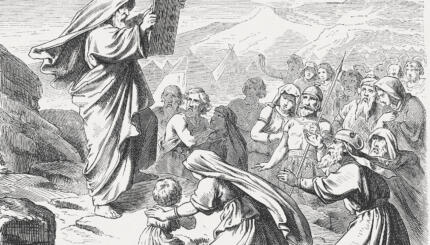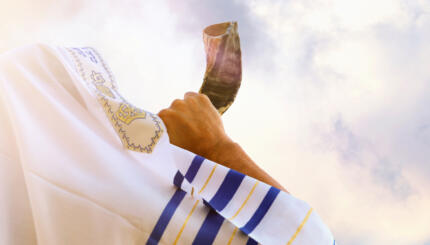When I think about Shavuot, the first image that pops into my head is a mob of Israelites gathered at the base of Mt. Sinai, impatiently waiting to receive the Torah amidst shofar blasts, smoke, and lightning. This image inevitably triggers Merle Feld’s poignant poem, “We All Stood Together,” and Judith Plaskow’s iconic book,
Standing Again at Sinai
. Both of these feminist texts explore women’s absence from Jewish tradition and from the moment of revelation and explore the ways that Judaism can transform itself to become more inclusive. I am well aware that feminism and gender are essential lenses for my Jewish experience (after all, I do work at JOFA) but I was a bit surprised that my subconscious had designated Shavuot as a holiday of exclusion. The Torah tells us that women, along with men, were present at Mt. Sinai, and the
Midrash
, rabbinic commentary, teaches that all of the souls of future generations of Jews were present at Sinai. That seems relatively egalitarian. Upon further thought, I realized that Ruth, the protagonist of our Shavuot narrative, embodied the marginalization that I was sensing and that Shavuot is an appropriate time to engage with the topic of exclusion.
Ruth is a woman, a widow, a convert, a penniless immigrant, and a Moabite (a different, hated race forbidden from entering the Jewish people). She is an outsider in every sense of the word. And yet, she is at the center of our Shavuot story, and at the core of the narrative of the Jewish people, as the great-grandmother of King David.
On many holidays, we focus on the ways that Jews were excluded, marginalized, and victimized by other cultures. On Hanukkah, we were oppressed by the Greeks. On Passover, we were enslaved by the Egyptians. On Tisha B’Av, we were victimized by the Babylonians and the Romans. All of these holidays memorialize times when Jews were marginalized as a nation. Ruth is notable because she was marginalized by the Jewish people. She was an outsider in the Jewish community. Yes, Ruth was ultimately a “success story.” She converted to Judaism, married Boaz, a wealthy and prominent land owner in the community, and gave birth to Oved, the grandfather of King David. She ultimately overcame these disadvantages and was accepted into our Jewish narrative as the great-grandmother of King David and the paradigm of chesed, loving kindness, and selflessness. However, we should not focus solely on the end of the story, to the exclusion of her other identity markers. The story of Ruth should remind us of the ways that the Jewish community is still segmented, and should serve as an opportunity for us to explore the way that our community treats other individuals within the Jewish community, those who are “Other” because of their gender, their race, their socioeconomic or religious background.
On Shavuot, we have the rare opportunity to sit with our communities and study texts into the wee hours of the night until daybreak.
Tikkun Leil Shavuot
is an alternate reality with ebbing and flowing cycles of intensity—caffeine buzzes, catnaps, sugar rushes, crashes after the first few cups of coffee and pieces of cheesecake wear off. It can be a dreamy time, learning underneath the stars, finishing up that final
chevrutah
as the birds start chirping and the sun rises, eagerly anticipating receiving the Torah anew, and imagining what our ideal Jewish community should look like.
We have the opportunity to examine the big questions: What does it mean to receive the Torah? How does the Torah impact us all differently? How do we engage with the more difficult, exclusionary aspects of the Torah and halakhah? How can we build a more inclusive community? A more committed community? How can we create a community that would welcome and accept Ruth, a community that values and encourages the equal contributions of women to our ritual community? How will the Torah help us build the Jewish world that we are craving?
This Shavuot, let’s embrace the opportunity to discuss those big questions, and explore ways to build the more equitable Jewish community that we crave. We could start by inviting more women to teach classes and address the congregation from the bima, including mothers’ names in ketubot and aliyot, offering more childcare options during prayers and classes, or simply welcoming everyone with a warm smile, and the question, “How would you like to participate in our community?”
Like this post? Join the conversation through MyJewishLearning’s weekly blogs newsletter.
Shavuot
Pronounced: shah-voo-OTE (oo as in boot), also shah-VOO-us, Origin: Hebrew, the holiday celebrating the giving of the Torah at Mount Sinai, falls in the Hebrew month Sivan, which usually coincides with May or June.
shofar
Pronounced: sho-FAR or SHO-far, Origin: Hebrew, a ram’s horn that is sounded during the month of Elul, on Rosh Hashanah, and on Yom Kippur. It is mentioned numerous times in the Bible, in reference to its ceremonial use in the Temple and to its function as a signal-horn of war.
Torah
Pronunced: TORE-uh, Origin: Hebrew, the Five Books of Moses.



